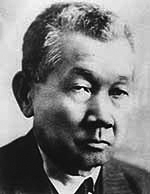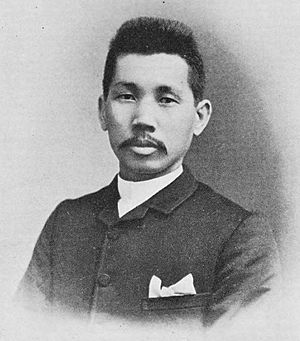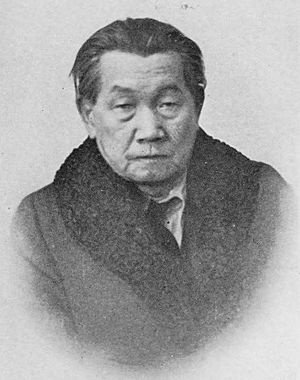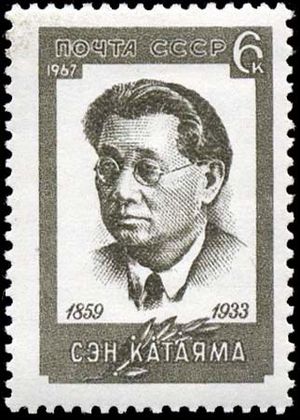Sen Katayama facts for kids
Quick facts for kids
Sen Katayama
|
|
|---|---|
| 藪木 菅太郎 | |
 |
|
| Born |
Yabuki Sugatarō
26 December 1859 Okayama, Okayama Prefecture, Japan
|
| Died | 5 November 1933 (aged 73) |
| Resting place | Kremlin Wall Necropolis, Moscow |
| Education | Oka Juku (preparatory school), Grinnell College, Andover Theological Seminary, Yale Divinity School Maryville College |
| Occupation | Rice farmer, journalist, printer's apprentice, newspaper editor |
| Known for | Co-founder of the Japanese Communist Party. Early member of the Communist Party USA. |
| Criminal charge(s) | Participation in the 1912 Tokyo Streetcar Strike |
| Spouse(s) | Fude. Hari Tama. |
| Children | 3 children |
| Parent(s) | Kunizo Yabuki, Kichi Yabuki |
Sen Katayama (片山 潜, Katayama Sen, December 26, 1859 – November 5, 1933), born Yabuki Sugataro (藪木 菅太郎, Yabuki Sugatarō), was an important Japanese political activist and journalist. He was one of the first members of the American Communist Party and helped start the Japanese Communist Party in 1922. After 1884, he lived mostly outside Japan, spending a lot of time in the United States and the Soviet Union. He was very active in international groups that supported socialist and later communist ideas. While not widely known in Japan, he was seen worldwide as a key voice for Japanese socialist and communist movements.
Contents
Growing Up and Getting an Education
Sugataro Yabuki was born in 1859 in Japan's Okayama Prefecture. He was the second son of Kunizo and Kichi Yabuki. When he was nineteen, he was adopted by the Katayama family and took the name Sen Katayama. This adoption helped him avoid being forced into the military and allowed him to continue his studies. In his own story, called Jiden, Katayama said he was lucky not to be the first-born in his birth family. This saved him from some tough responsibilities.
In 1878, Katayama went to Tokyo to learn how to be a printer. He also studied at a small school called Oka Juku. There, he became friends with Iwasaki Kiyoshichi, whose uncle helped start the big company Mitsubishi. Iwasaki went to Yale University, which inspired Katayama to travel to the United States too. Katayama studied at Maryville College and then Grinnell College, graduating in 1892. He continued his studies at Andover Theological Seminary and Yale Divinity School. During this time, he became a Christian and started believing in socialist ideas.
His Career and Activism
Katayama returned to Japan in 1896. From 1897 to 1901, he worked as an editor for a newspaper called Labour World. This paper was connected to Japan's first socialist groups, like the Iron Workers' Union. In 1903, he went back to America to explore rice-farming opportunities. While there, he attended a big meeting of socialist leaders in Amsterdam. He became well-known for shaking hands with a Russian delegate, G. V. Plekhanov. This was a symbol of friendship between the Russian and Japanese people, even though their countries were fighting in the Russo-Japanese War at the time.
In 1904, he went to a meeting of the American Socialist Party in Chicago. He then settled in Texas and focused on rice farming. When his farm didn't do well, he worked for a Japanese restaurant owner in Houston. This owner, Tsunekichi Okasaki, bought a large piece of land in Texas for Katayama to farm. They borrowed money to fund the rice harvest and started a company called "Nippon Kono Kabushiki Kaisha" (Japan Farming Company). Katayama was the managing director. However, the company quickly ended, supposedly because of Katayama's socialist beliefs. He returned to Japan in 1907 and continued his work in journalism and the socialist movement.
Katayama was arrested and put in jail for being part of the Tokyo Streetcar Strike in 1912. After he was released, he moved to California. He was very interested in the success of the October Revolution in Russia, which led to the rise of communism. Katayama became an active communist and worked for the Communist International, an organization that promoted communism worldwide. He traveled to Mexico and later to Moscow, where he was celebrated as a leader of the Japanese communist movement. He stayed in the Soviet Union until he passed away on November 5, 1933. His ashes were buried in the Kremlin Wall Necropolis in Red Square, a very important place in Moscow.
Family Life
Sen Katayama had two children with his first wife, Fude, who died in 1903. He later married Hari Tama in 1907, and they had one daughter.
His Writings
- The Labor Movement in Japan. Chicago: Charles H. Kerr & Co., 1918.
More to Explore
 In Spanish: Sen Katayama para niños
In Spanish: Sen Katayama para niños
- Shinkigen




